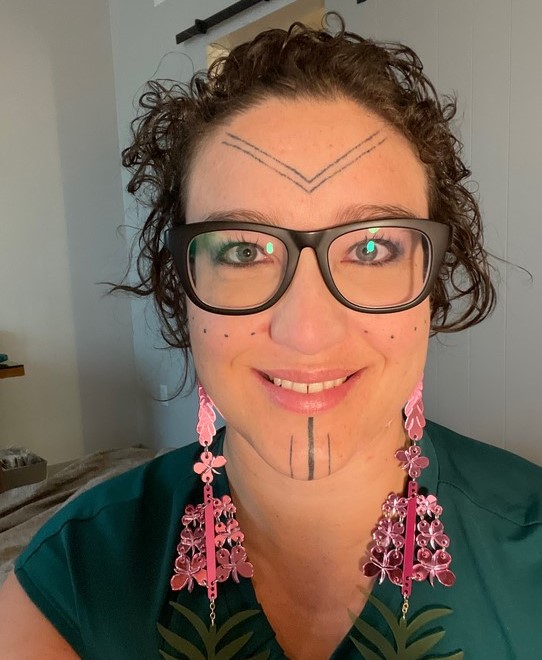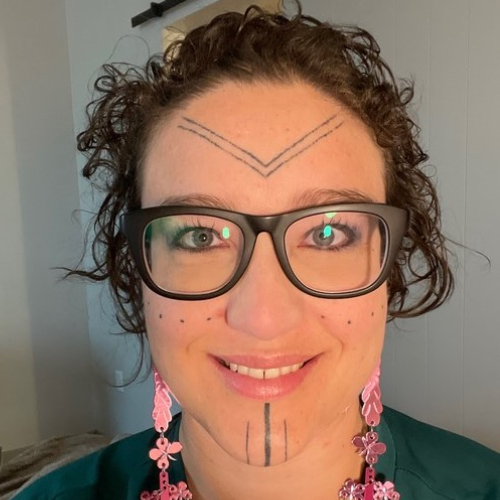

In conversation with Heather Sauyaq Jean Gordon
Heather is an Iñupiaq Indigenous woman from Alaska. The Iñupiat are the Inuit people in Alaska and are related to Inuit in Canada and Greenland.
She grew up in the city of Homer on Alaska’s Kenai Peninsula far south of where the traditional lands of the Iñupiat are, on the traditional lands of the Ninilchik Village Tribe.
“Academically, I did a degree in Indigenous studies with a background in sociology, and race and ethnic studies,’ explains Heather, ‘So, I’ve been working in these spaces of communicating across different cultures, across different ways of knowing as well as working around stereotypes, racism and things like that, since I first started my undergrad.
I’m also and Arctic Fulbright scholar recently returned from our midyear meeting in Greenland.”
Indigenous Virtual Exchange Resources
As colleague Izzy Crawford previously explained, the University of the Arctic (UArctic) is currently developing international classroom collaborations. Heather explains that the goal is to be able to have such collaborations within Indigenous communities through colleges and high schools.
“I was tasked with creating resources for educators to be able to start relationships building with Indigenous communities. The information I put together includes: who Indigenous Peoples are, background on lands and languages of the Arctic, the differences between the various communities based on different colonial backgrounds, current ways of life, and social and economic systems including access to land.
I explain what settler colonialism is, how it’s ongoing, and the way it impacts Indigenous rights and sovereignty.
Without a basic understanding, people tend to re-harm these communities and replicate past colonial behaviour and this behaviour risks closing a community to future things like access to VE/COIL projects for example.”
Virtual exchange and the best of intentions
Heather says that the best of intentions is often not at all good, especially when you don’t have any understanding of the community, its colonisation and cultural background.
“We see this a lot in research, where results are shared with the media prior to being contextualised by the community. Researchers tend to focus on community deficits and these blow up into potentially huge issues where the community feels it has not been listened to. I believe a more contextualised and nuanced approach would benefit everyone.”
The two main pages on the website are: Introduction to Indigenous people. The other concerns ethical considerations and demonstrates what has emerged as a result of these harms, explains Heather. She cites the Barrow alcohol study from the 1970s which failed to focus on the harms done by colonialism, but instead where researchers went to the media to say they didn’t envisage this community surviving beyond the year 2000.
“And I am here to say we are surviving and thriving beyond that and I am from that society!“
“So, I encourage that engagement, with a partner, to learn, before anything starts, that’s what we would like you to do!”
Role of VE in moving forward
One thing that excited Heather about the building up of COIL/VE projects was the possibility for non-Indigenous students to learn from, with, and about Indigenous Peoples. Preferably the learning needs to take place before they become one of those future researchers who will then bombard Indigenous communities.
“Ultimately, explains Heather, ‘when they meet each other and learn from each other, they find how much more they have in common rather than how different they are.”
“So, to understand what these communities look like and understand what people are thinking, these kinds of collaborations enable them to understand the value of indigenous lives and voices.
On the other hand, for the indigenous students, Heather felt excited by the idea of VE/COIL because due to financial constraints, it’s unlikely they’ll get to travel to Scotland or wherever, being from rural Alaska. It allows young people from rural communities to learn about how people live in cities, about living in a place with extensive diversity with immigration, and what culture, identity, environment, and economy mean in such different spaces.
“The virtual exchange allows young people to build relationships, recognise commonalities, and understand the value of Indigenous Knowledges – all the while still being in a learning space and open to new perspectives before they develop their ‘expertise’ that seems to supersede all else in academic spaces.
Most critically it allows young people to build relationships that are vital in the contentious world we live in.”
Heather’s VE/COIL experience
During her grad school, Heather took part in a VE/COIL, which connected students from Alaska to others from Hawaii and NZ. It was one of the most interesting learning experiences for her, she says, as the teachers really stepped back and the learning was really led by the students.
“That is a fantastic leadership model and growth building. A lot was done asynchronously due to time zones. Despite this, we got to learn from people who were just like us, but located in another place. ‘Place’ drives our identity so much and is an integral part of who we are and influences how we see the world.
This was a massive learning for me. And now I am eager to develop an evaluation to understand the impact of these models and the experiences people are having in the process.”
Memories of VE/COIL
Heather remembers how the students wrote to each other, and she remembers how ‘place’ and ‘sense of place’ were so significant.
“We are so linked to our place. And a larger surprise for me was how similar we are although we come from different climates. Our connection to the land and our values are very similar. The relationship between humans and the land were so commonly shared be it in cold or warm climes.
“This shaped my future outlook and my work in that I believe we can share values across the continents as people. No matter how different we are and amidst all this contention we see right now, we have values we can share.
Building connections through COIL/VE can help diplomatic relations for example, going forward.”
Final reflections
The UN’s Sustainability Development Goals are integral in the building of a COIL/VE programme at UArctic.
“Sustainability science is my background, says Heather, ‘and sharing Indigenous relationships to the land demonstrates we can have a relative-based kinship with the land and communicate that through our values. We can build out from these shared values and I think VE/COIL can help us do that especially when travel isn’t an option.”
Heather encourages you to visit the resource pages and learn a bit about the community.
“It’s really important for those wanting to do research; the ethical work is essential. Do what is right for the communities you want to partner with, ask to partner, do your homework putting in the time to learn about them before you arrive, and ensure you don’t further harm those you are going to collaborate with. Do your due diligence is my message going forward.”
